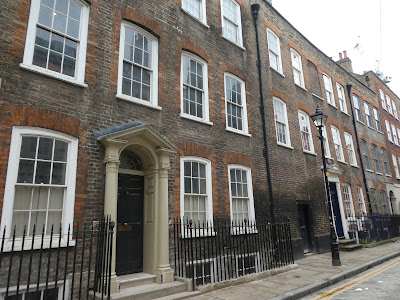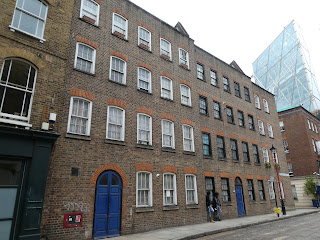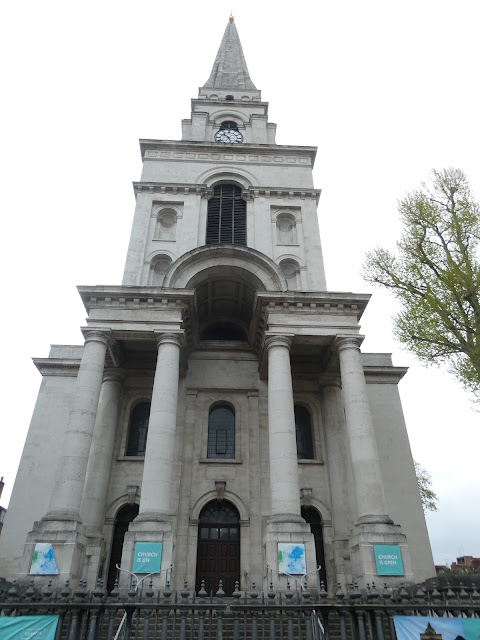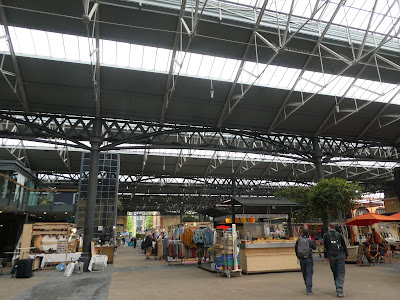"Spitalfields" is a contraction of "Hospital Fields" (obvious when you think about it) and forms a sort of buffer between the City and the East End. There was an Augustian hospital here founded in 1197, but it disappeared following the dissolution of the monasteries by King Henry VIII in 1538. Almost no trace remains.
This was a circular walk starting and finishing at Liverpool Street station, one of the main modern entrances to the City. Hate to think of the number of passengers who would come through here on a normal weekday morning. It is surrounded by some of the tallest skyscrapers in the City - very 21st century - although all the place names, such as Spitalfields or Bishopsgate, hark back to a much earlier time period. What is so remarkable is how fast the change is around here from soaring glass tower block to 18th century terrace.
But first something in between, because of course the commercial city had a first growth spurt in the 19th century and many of the offices around here are preserved Victorian edifices, albeit sometimes retaining nothing but the facade. But here is the Bishopsgate Institute still used for its original purpose, and in a very idiosyncratic Victorian style - Gothic castle like.



But then a turn to the right and one is in the early 18th century with Folgate Street. All these fine Georgian buildings owe their existence to the French. And religion. For this area was all the preserve of the Huguenots escaping religious persecution from the Catholics in France. And it just so happened that the Huguenots were skilled silk weavers, and who doesn't like silk? The Huguenots arrived in their tens of thousands in the late 17th century and settled just outside the City. Settled and prospered. Was not the last time that Britain would gain from taking in persecuted minority groups - Russian Jews would follow in the 19th century, Ugandan Asians in my younger days. And my hope is that we gain an influx of Hong Kong Chinese soon. If so will be interesting to see where they settle.
Anyway, back to the 18th century and the silkweavers houses. There are several streets like this around here, all with now listed houses. Note the early Georgian town house format - flat front, four storeys, windows that are symmetrical but receding in size as you go up the storeys, and grand front doors.
This is Denis Sever's House, a house restored to its Huguenot origins. Note the silhouettes in the first floor windows - zoomed in below.
Here is a good example of the juxtaposition of 18th and 21st centuries - terrace in front with glass skyscraper looming beyond.
A little French street name too.
Now I did mention that there was
almost no trace left of St Mary Spital, the medieval hospital. There is none above ground. But they found some below ground when excavating around Spital Square, so you can go down a few steps and peer into a glass front to see the remains of St Mary's charnel house, where the bones of the deceased were stored. It now has an odd modern sculpture inserted to liven up the ruins a bit.
And opposite is a set of colourful story boards.
Above ground the area has modern office and retail space, and a herd of elephants. They are set here by a wildlife trust and make a nice if curious addition to the square. The fact that they are dotted around makes them particularly appealing.
Much weirder are a couple of hare and hound statues. Or rather Dogman and Rabbit Girl by Gillie & Marc (who also made the elephants). They are part of a "global campaign to spread love."
This one is especially unsettling! (But I really like them.)
But possibly the most unlikely statue is Kenny Hunter's the Goat - a goat on concrete boxes.
Apparently
The goat stands as a symbol for the various waves of migration that have found sanctuary in Spitalfields and helped to shape it. The goat, as an image of persecution and sacrifice, reflects how each successive group of immigrants have faced their own combination of conflict, oppression and poverty, all eventually finding a new home in London. The crates on which it stands reference the market as well as the ongoing history of transience and human flux.
No doubt that is exactly what one thinks of when first seeing a goat on a pile of cases....
The outstanding sight in Spitalfields is Nicholas Hawksmoor's Christ Church Spitalfields, built between 1714 and 1729, and very much built to impress. It is best viewed at a distance, looking down Brushfield Street. Up close it is just a little scruffy, despite having been restored after being left derelict, like other city churches having lost most of its congregation while being a truly huge church.
Up close it is rather hemmed in by other developments and its graveyard is rather unkempt. I have kept the horrible misshapen little modern brick adjunct out of the photos!
The Ten Bells pub, established in 1755 and apparently a favourite haunt for prostitutes back in the days of Jack the Ripper
Fournier Street (with Bangladeshi subtitles) which is considered to contain some of London's finest Georgian houses, dating from around the 1720s and originally occupied by prospering Huguenot weavers. These houses over the succeeding years became almost derelict and crammed with the poor, but are now restored and worth millions.
Although hard to photograph because of the height and narrowness of the street, many of these houses have big windows up in the attics, beyond the normally neatly proportioned Georgian windows which recede in height as you go up the floors. The reason for this is that these attic rooms contained the weavers looms, so the weavers could work in the best light.
Thee is one old shop front from a house turned into a Jewish shop - S. Schwartz. The area was a big Jewish one in the 19th and early 20th centuries.
On the corner of Fournier Street and Brick Lane is Jamme Masjid Mosque. This is of great historic interest as originally it was founded as a church by the Huguenots in 1743 and called L'Eglise Neuve. As the Huguenots faded away as a separate group, it got taken over by the London Society whose mission was to convert Jews to Christianity, a mission which failed miserably, so it became a Methodist church, until 1897 when it became the Spitalfields Great Synagogue.
However, the Jewish population largely left the area for pastures new after World War II and so its dwindling congregation gave up and it converted to a mosque to serve the area's newest immigrants, the Bangladeshis. Of course, it is listed so it couldn't be turned into the more familiar shape of a mosque, so instead it has a minaret erected outside, with the slight air of an industrial chimney.
Brick Lane is of course famed for its curry houses. It is tatty and commercialized, but thriving. The name derives from the brick kilns that once lined it. I would rather have a curry house than a brick kiln as a neighbour!
Christ Church School
The Moorish Market, built in 1905, now a fashion college.
As is spelled out across the middle in brick, here is the Soup Kitchen for the Jewish Poor, built in 1902 (or 5662 in the Jewish Calendar) in quite a grand manner for its purpose. Sufficiently grand that is is now converted into flats.
The name here is of interest - Tenter Ground. Medieval textile workers hung out their cloth to dry on wooden frames called "tenters". Hence the expression "hang on tenterhooks". Didn't know that? You see, every day is a school day!😀
This building on the corner is of interest only for its construction. It is commonplace for central London buildings of vintage to be gutted and retain only their original facade. But usually the facade is the facade, ie actually the front wall. Here they have retained the facade as only a shell and built completely anew behind it.
This little street is Artillery Passage a bit of a time capsule from 200 years ago.

It's most remarkable feature is a pair of Georgian houses with shop fronts dating from 1756. It is quite something for a shop front not to have been altered in 250 years of commerce. Hence it is Grade 1 listed.
Sandy's Row, with a synagogue still operating.
Spitalfields Market is longstanding, but the current buildings date only to 1887. The market still operates.
This is another little alleyway, Puma Court, with almshouses half way down.
Princelet Street - more Georgian Huguenot residences
This house was built for a Huguenot family in 1719, but was taken over by a group of Polish Jews in 1869 who built a synagogue in the back yard.
At this point in my walk around Brick Lane I realised I was close to Rough Trade records, so I nipped in and bought the new Coral album. (Back into the 21st century!)
The Old Truman Brewery managed to keep going for 300 years but closed in the 1980s. Its fine old buildings are now let to small business units.
This is the shop sign for one of the last Jewish businesses in the area to survive - bag shop.
Now Brick Lane's commercial life is solidly Bangladeshi with particular reference restaurants. This one used to be a pub, the brick at the top depicting frying pans - fitting as it was once Ye Old Frying Pan pub.
And here is the old business that survived the longest - it only closed a couple of years ago. It is the premises of the Whitechapel Bell Foundry whose origins dated back to 1420. Six hundred years is a hell of a long time for one business.
This Gothic red brick fortress is the Tower House, now converted into expensive flats but once a cheap men's hostel.
This water fountain is about all that is left of the church of St Mary Matfelon that was destroyed in the Blitz. The church had whitewashed walls so was known as the White Chapel - hence the area is called Whitechapel.
Whitechapel Art Gallery built in 1899 by the same man as designed the Bishopsgate Institute at the start of this entry.
The Jewish coat of arms of the Jewish Post & Express newspaper that used to be here before the War.
Toynbee Hall, once home to the charity of which I am a director.
And now back into views of the City....
But on the edge of the City is this excellent development at Devonshire Square, making use of the old East India Company warehouses and offices. A great example of restoring old buildings and meshing them with new ones.




















































































































No comments:
Post a Comment